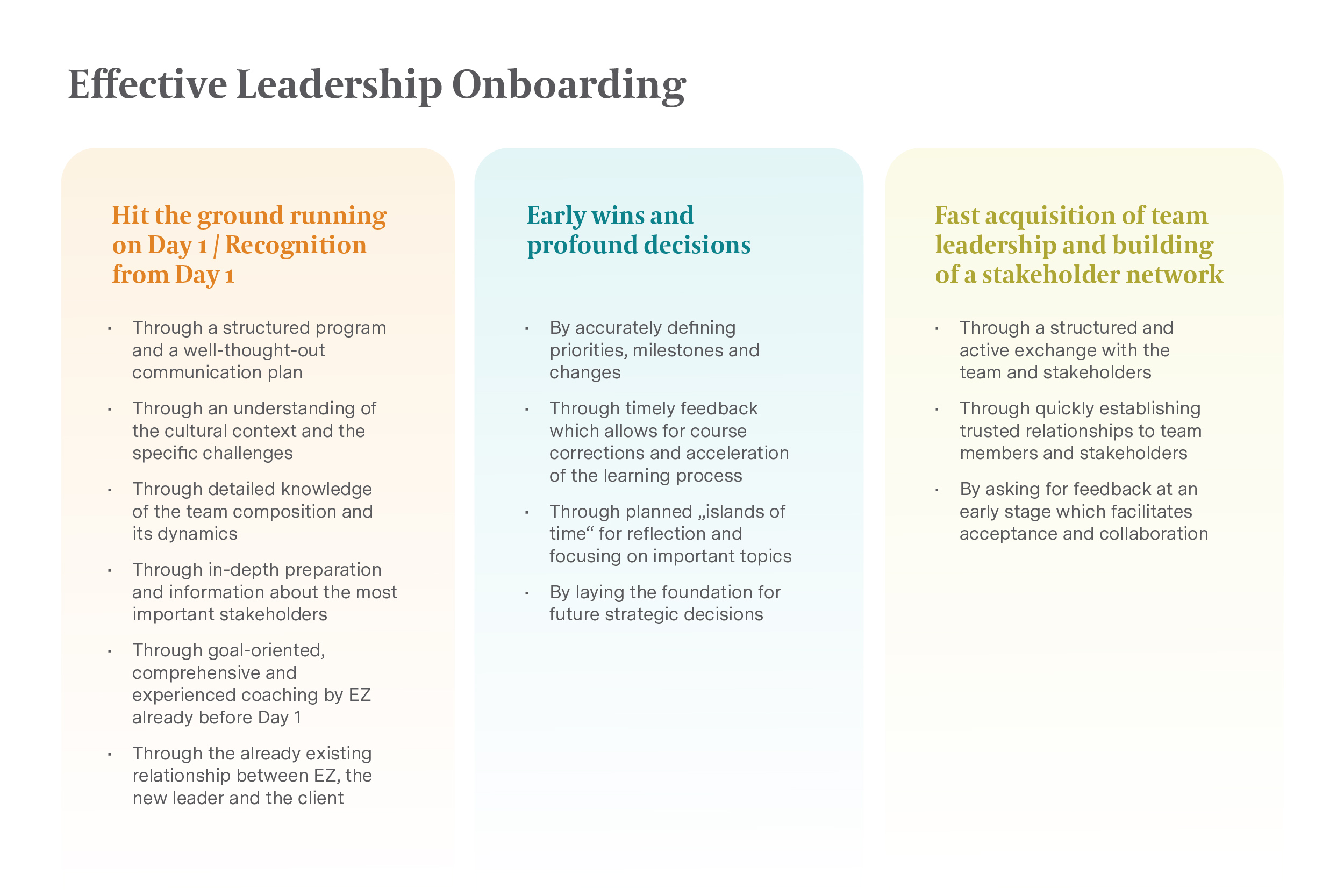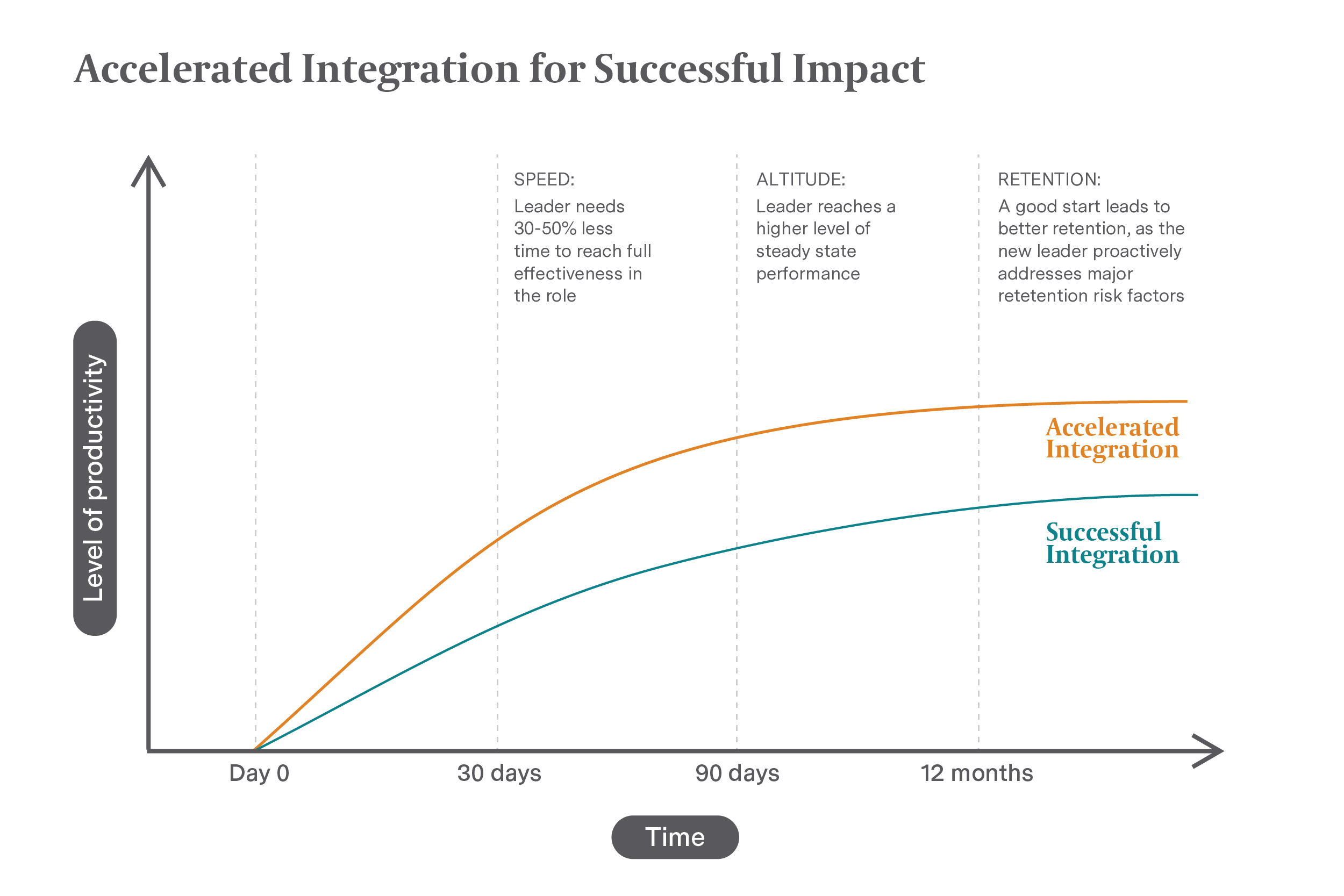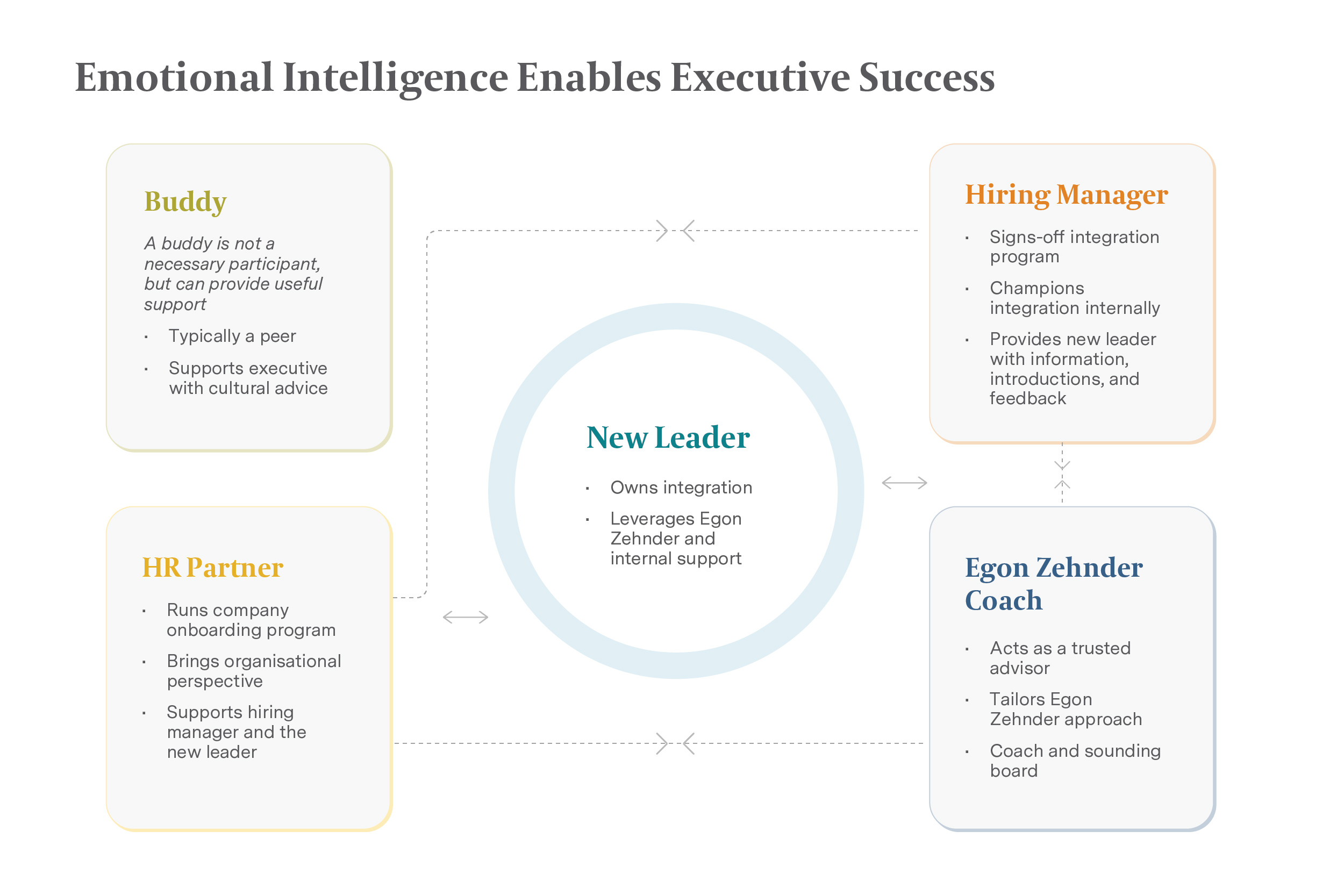Effective leadership onboarding means more than just checking the boxes – it serves as a strategic investment in setting executives up for success when they take on a new role. Whether a leader is transitioning from another organization or stepping into a new internal position, thoughtful onboarding gives them the tools to thrive early and build a lasting impact.
Keren Latzer, Consultant for Egon Zehnder who specializes in human resources, emphasized, "The first 100 days are often make-or-break for new leaders." If leaders don’t land well, they risk leaving or being asked to exit. A well-designed onboarding process maximizes early wins, reinforces cultural alignment, and sets the stage for long-term executive leadership development.
Before diving into the five proven steps to effective leadership onboarding, it’s important to understand what differentiates great onboarding from standard orientation – and why the correct onboarding process matters more than ever.

Why is a Structured Leading Onboarding Process So Important?
Why is a Structured Leading Onboarding Process So Important?
At the executive level, the stakes are higher, expectations are sharper, and support is often lower than in entry-level transitions. In fact, according to a survey conducted by Paychex analyzing results from 1350 human resources leaders, 70% agree or strongly agree that success or failure during a transition period is a strong predictor of overall success or failure in the role.
The more senior you are, the less structured feedback you typically receive.
 Mary Reid ErvinLeadership Advisory Consultant for Egon Zehnder
Mary Reid ErvinLeadership Advisory Consultant for Egon Zehnder
Leaders are expected to deliver results quickly, navigate complex cultures, and integrate into existing teams – all without much real-time guidance.
Without a structured onboarding plan, even highly capable leaders can falter. Strategic onboarding helps mitigate risk, ensures cultural fit, and enables new executives to drive impact quickly.
What is the Difference Between Leadership Onboarding and Orientation?
What is the Difference Between Leadership Onboarding and Orientation?
Orientation focuses on basic logistics – getting an ID badge, completing compliance training, learning company policies. Leadership onboarding, by contrast, is about strategic immersion: integrating into stakeholder networks, understanding cultural nuances, establishing operational control, and beginning to drive strategic intent.
Onboarding starts long before the leader walks in the door – and it continues well beyond their first day.
 Mary Reid ErvinLeadership Advisory Consultant for Egon Zehnder
Mary Reid ErvinLeadership Advisory Consultant for Egon Zehnder
The Importance of Accelerated Integration in Leadership Onboarding
The Importance of Accelerated Integration in Leadership Onboarding
Accelerated Integration reduces the time it takes for a new leader to reach full effectiveness by nearly 50% – yet, according to a survey by Egon Zehnder, only 2% of global companies offer accelerated integration onboarding. Rather than leaving executives to sink or swim, a structured onboarding program proactively connects them to culture, teams, and strategic priorities—fast-tracking both trust and performance.

5 Proven Steps for Better Leadership Onboarding
5 Proven Steps for Better Leadership Onboarding
Below, we outline five comprehensive steps to create an effective leadership onboarding program, supported by practical advice, real-world insights, and quotes from experienced consultants:
1. Remember That Leadership Onboarding Starts Before They Even Walk in the Door
1. Remember That Leadership Onboarding Starts Before They Even Walk in the Door
Establish Strong Relationships with Stakeholders
Establish Strong Relationships with Stakeholders
Arrange meetings with Board members, cross-functional peers, and direct reports before day one.
Having line of sight into key stakeholders early helps new leaders get grounded more quickly.
 Mary Reid ErvinLeadership Advisory Consultant for Egon Zehnder
Mary Reid ErvinLeadership Advisory Consultant for Egon Zehnder
Ensure Organizational Readiness
Ensure Organizational Readiness
Prepare materials such as financial reports, strategic plans, board meeting agendas, and organizational charts.
Materials that help contextualize the organization from day one are critical.
 Keren Latzer
Keren Latzer
Communicate with Purpose
Communicate with Purpose
Clarify early goals and how the new leader’s role signals organizational priorities. Engage the broader team for feedback and buy-in – alignment from the start builds trust.
2. Create the Leadership Onboarding 30-60-90 Day Plan
2. Create the Leadership Onboarding 30-60-90 Day Plan
Tailor Onboarding for Different Executive Roles
Tailor Onboarding for Different Executive Roles
Internal promotions, external hires, and founder-successor transitions all require customized onboarding.
Even internal promotions involve an identity shift—colleagues must see the individual in a new light.
 Keren Latzer
Keren Latzer
For New Hires: Identify Quick Wins
For New Hires: Identify Quick Wins
Early victories build momentum. Whether it's completing a project, securing a key hire, or leading an initiative.
Helping someone achieve an early win is essential for establishing credibility.
 Mary Reid ErvinLeadership Advisory Consultant for Egon Zehnder
Mary Reid ErvinLeadership Advisory Consultant for Egon Zehnder
3. Utilize Connections Across Your Organization for Role Success
3. Utilize Connections Across Your Organization for Role Success
The Role of the Board in Executive Onboarding
The Role of the Board in Executive Onboarding
The Board should actively support new executive transitions – setting clear expectations, facilitating introductions, and helping embed the leader into strategic conversations.
Building Credibility
Building Credibility
New leaders should balance honoring what works with proposing fresh ideas.
Proactively discussing cultural preservation helps build credibility
 Keren Latzer
Keren Latzer
Find an Internal Sponsor
Find an Internal Sponsor
Internal sponsors are critical allies – especially during a time of immense change.
Sponsors give you access, context, and feedback – they help you thrive in a new environment.
 Mary Reid ErvinLeadership Advisory Consultant for Egon Zehnder
Mary Reid ErvinLeadership Advisory Consultant for Egon Zehnder
4. Consider Executive Leadership Development Beyond the First Quarter
4. Consider Executive Leadership Development Beyond the First Quarter
Integrate the Leader into the Broader Strategy
Integrate the Leader into the Broader Strategy
Ensure the leader’s role is aligned with the company's long-term goals.
Create Opportunities for Change
Create Opportunities for Change
Empower new leaders to suggest innovations. Welcoming new perspectives fosters organizational evolution without abandoning cultural roots.
Invest in Executive Leadership Development
Invest in Executive Leadership Development
Structured development doesn’t end after 90 days. Executive coaching, mentorship, and regular feedback loops are crucial.
5. Evaluate the Leadership Onboarding Process
5. Evaluate the Leadership Onboarding Process
Focus on measurable results – early wins, cultural assimilation, and stakeholder trust – rather than simply checking boxes.
Track Outcomes, Not Just Activities
Track Outcomes, Not Just Activities
"Get feedback early and often," advised both Keren Latzer and Mary Reid Ervin. Gather perspectives from peers, teams, and leadership to guide continuous improvements.
Solicit Holistic Feedback (and Keep the Lines Open)
Solicit Holistic Feedback (and Keep the Lines Open)
Even the best-designed onboarding programs require ongoing refinement. Solicit input not just from the new executive, but also from their peers, direct reports, and key stakeholders. This 360-degree feedback helps surface blind spots, clarify expectations, and strengthen alignment.
Refine Your Onboarding Playbook
Refine Your Onboarding Playbook
Onboarding should evolve with each executive transition. Adjust based on feedback, new challenges, and organizational growth.
Common Pitfalls for Leadership Onboarding (and How to Avoid Them)
Common Pitfalls for Leadership Onboarding (and How to Avoid Them)
Even the best leadership onboarding plans can falter without careful execution. Common pitfalls often stem from false assumptions, missed opportunities for feedback, and a lack of strategic alignment. Addressing these early can dramatically improve a new leader’s integration and long-term success.
Below, we outline the most frequent onboarding mistakes organizations make – and how to proactively avoid them:
Assuming Company Culture is Obvious
Assuming Company Culture is Obvious
Many organizations believe their culture is obvious to new leaders – but it’s not.
Assuming that culture is obvious without talking about it is a missed opportunity to foster a quick connection between the leader and the organization
 Mary Reid ErvinLeadership Advisory Consultant for Egon Zehnder
Mary Reid ErvinLeadership Advisory Consultant for Egon Zehnder
Without deliberate guidance, new leaders may misinterpret unspoken norms or struggle to connect authentically. Early conversations about values, behaviors, and "how work gets done here" are crucial for rapid cultural alignment.
Not Creating Strategic Feedback Loops
Not Creating Strategic Feedback Loops
In leadership onboarding, proactive, structured feedback is essential. Establish a strong cadence of pulse checks, 360-degree reviews, and peer input to surface issues and celebrate successes, allowing the leader to course-correct while building confidence.
No Defined Onboarding Process
No Defined Onboarding Process
An informal or ad-hoc approach to onboarding often leads to confusion and missed opportunities.
Throwing leaders in without a plan leads to sink-or-swim outcomes.
 Keren Latzer
Keren Latzer
A clear, structured onboarding framework – tailored for executive roles – can provide critical guidance and ensures consistent experiences across leadership transitions.
Misaligned Expectations Between the Executive and Organization
Misaligned Expectations Between the Executive and Organization
One of the most damaging pitfalls is a disconnect between what the leader expects and what the organization needs. Misaligned visions, goals, or leadership styles can derail success early. To avoid this, set clear expectations upfront about performance milestones, leadership behaviors, and strategic priorities – and revisit them regularly during the first year.
Siloed Integration of a Key Leader
Siloed Integration of a Key Leader
Leadership onboarding must extend beyond immediate teams. Executive leaders need to build relationships across departments, geographies, and functional areas to drive real impact. Encourage broad networking and cross-functional collaboration from the start that goes beyond just direct reports.
Leadership Onboarding for Crisis or Turnaround Situations
Leadership Onboarding for Crisis or Turnaround Situations
When a company faces a crisis, major disruption, or a turnaround situation, leadership onboarding requires a different pace and mindset. The stakes are higher, the margin for error is smaller, and the pressure for immediate results is far greater.
Unlike standard onboarding, where leaders are given time to learn the culture and gradually influence the organization, crisis onboarding demands rapid alignment with the existing culture, fast-tracked trust-building with stakeholders, and swift operational impact. However, speed and stability are equally important.
In a turnaround, you’re balancing speed with stability.
 Keren Latzer
Keren Latzer
To succeed, onboarding during crisis situations should focus on:
- Prioritizing culture and expectations early: New leaders must understand the cultural realities they are stepping into, including what is working and what must urgently change. Conduct candid, upfront conversations about the organization's current state – both strengths and pain points – so leaders aren't flying blind.
- Accelerated stakeholder mapping: New executives must know exactly who their critical stakeholders are from day one and begin building those relationships immediately. Early alliances with the board, senior executives, and influential team members can smooth decision-making and help drive quick wins.
- Clarity on immediate goals: Success metrics must be clear and achievable within the first 30-60 days. Whether it's stabilizing operations, rebuilding a leadership team, or resetting organizational priorities, defining short-term victories is essential for building momentum.
- Transparent communication strategies: Leaders must communicate frequently, candidly, and empathetically with employees and stakeholders. In times of uncertainty, overcommunication is better than silence.
- Support systems for the leader: In crisis onboarding, new executives benefit from close coaching, real-time feedback, and candid sounding boards to help them navigate challenges without becoming isolated.
Organizations that invest in structured, crisis-specific onboarding dramatically increase the odds that new leaders can stabilize operations, regain organizational trust, and set the business on a path to recovery – and beyond.
Building a Repeatable Executive Leadership Development Framework
Building a Repeatable Executive Leadership Development Framework
Effective leadership onboarding should not be treated as a one-time event. It is most successful as part of a broader, repeatable executive leadership development framework that organizations refine and strengthen over time. A structured, ongoing framework ensures that every leadership transition – whether it’s a CEO, C-suite executive, or key business unit leader – is handled with the same level of rigor, consistency, and strategic foresight.
A repeatable framework allows companies to minimize disruption and maintain momentum even through major leadership changes. It also ensures that leadership development is continuous, not reactive, reducing the scramble when a transition suddenly arises.
Key Components of a Strong Leadership Development Framework
Key Components of a Strong Leadership Development Framework
- Strategic alignment: The goals of leadership onboarding must tie directly to the organization’s long-term business strategy and evolving goals. Beyond just filling a seat, it’s about preparing leaders who will advance the company's future direction.
- Talent pipeline visibility: Regular talent reviews, succession planning, and leadership assessments create a clear understanding of who is ready now, who will be ready later, and what gaps exist in the pipeline.
- Tailored development journeys: No two leaders are identical. Development frameworks should be customized to each leader's role, personal potential, and growth areas. Tools like executive coaching, cross-functional assignments, and external mentorship can help with this.
- Cultural assimilation: Successful leaders are not just operationally effective – they are culturally aligned. A repeatable framework ensures new executives receive deliberate exposure to company values, norms, and behaviors right from the start, avoiding assumptions that culture will "speak for itself."
- Accelerated integration processes: Embedding new leaders into networks across the organization early on – through structured stakeholder mapping, integration plans, and cultural diagnostics – reduces time to effectiveness.
- Continuous feedback and adaptation: Structured feedback loops, including 360-degree reviews and real-time pulse surveys, allow organizations to monitor onboarding success, course-correct where needed, and continuously improve the framework with each transition.
- Crisis readiness: ]Leadership transitions don’t always happen under ideal circumstances. A repeatable development framework should also account for unplanned changes – ensuring an organization can pivot quickly while still maintaining a high standard for onboarding quality and leadership assessment.
Succession planning and onboarding shouldn't be reactive. They should be treated as an ongoing, strategic process—woven into the fabric of how the organization grows and evolves.
 Keren Latzer
Keren Latzer
By institutionalizing a repeatable leadership development and onboarding process, companies safeguard against risk, deepen their leadership bench strength, and position themselves for long-term resilience in an unpredictable world.
The Role of Emotional Intelligence in Executive Leadership Development
The Role of Emotional Intelligence in Executive Leadership Development
Emotional intelligence is critical to executive success. Leaders must navigate ambiguity, build relationships, and foster trust. Embedding intelligence development into onboarding – through coaching, 360-feedback, and leadership assessments – creates more resilient and adaptable leaders

How External Partners Can Help with Leadership Onboarding
How External Partners Can Help with Leadership Onboarding
Effective leadership onboarding can define the success of a new executive – and the future of your organization. Partnering with an external expert like Egon Zehnder brings unique advantages to this critical process.
Our team provides an objective perspective, offering unbiased insights into culture fit, stakeholder alignment, and integration risks. We bring structured onboarding methodologies designed to accelerate a leader’s impact, reduce transition risks, and foster immediate alignment with organizational goals.
Through leadership and potential assessments, we help you identify strengths and development areas early, creating a tailored roadmap for success. And with deep, sector-specific expertise, our consultants deliver pragmatic, industry-informed advice – always grounded in the realities your leaders face.
"Unlike other firms, our consultants have industry backgrounds—we've stood in our clients' shoes," said Keren Latzer. "We bring structure, data, and empathy to every onboarding journey."
Need support with your onboarding process? Let’s build an executive onboarding experience that sets your leadership team, and your business, up for long-term success. Contact Egon Zehnder today to learn more about our unique approach to leadership onboarding and executive integration.





